Across the street from the studio, there is a mural for a local rap superstar whose life was cut short running down highway 35 with his assassins hot on his tail. 11am, morning time, the news reported. His name was MO3. Every day, cars pull up and people take photos in front of it. Souped up street cars, minivans with families, last week a Mustang wrapped in 100 Playboy Magazine covers, doughy overweight white guys in Cowboys jerseys. Sometimes they stand on their cars or beds of pickup trucks. Usually forming gang signs with great hand gestures for videos to post and share.
The MO3 mural in question, across the street from my studio.
Since I moved into my studio here four years ago, the neighborhood has rebranded from “West Dallas” to “the Tin District,” a real estate-minded move that’s touched other locales like the South Bronx back in NYC, which developers have tried to re-name “the Piano District” and “So-Bro” over the past decade. This part of Dallas is a graffiti frontier, on the same block as the Fabrication Yard where people can paint the many abandoned industrial buildings without fear of legal retribution. That’s not to say without retribution from the streets, where regular laws don’t always apply, but I haven’t seen much beef around these parts. Just a lot of photoshoots—everything from boudoir to baby announcements.
There’s numerous artist studios on my block—we keep a kind but cordial community, passing around tools like paint thinner and staples. I take photos for the tourists outside.
I’ve lived in this environment numerous times over my life. From the old SoHo to Greenpoint before the hipsters—no matter where I go, my presence signifies the tip of the gentrifying spear. It’s not on purpose, of course. I’m drawn to the atmosphere—edgy, artistic, and most importantly, affordable. Up-and-coming, that loaded term. Artists sometimes do the dirty work of developers, even when we have the best (or at least neutral) intentions. The thing about gentrification, however, that I think we’re all finding as the phenomenon wears on, is that there’s a potential deadening aftermath to the process. Once a place becomes saturated and popular, it loses its soul. The thing that once made it attractive dies, swallowed whole by the phenomenon itself.
My old live/work space in the basement of a cigar factory on Mercer Street in SoHo. Circa late 1990s.
I’ve been thinking about my own mortality lately, and not just because of the MO3 mural across the street. Stone faced and brooding like a man, I meditate on the inescapable reality of my own impending demise. I suppose it’s natural to feel this way at this point in life—the end being closer than the beginning. The “back nine,” I’ve heard people say, which I actually find quite funny because I live in a neighborhood with an old public golf course full of robust but aging luscious green trees.
The 1940s era house that I live in sits nestled on a winding street of unique homes, adjacent to the 9th hole of the golf course. Life imitates art—you can’t make this shit up. So I guess one could say I’m literally living on the “back nine.” The thing is, though, that no one actually knows where the true “back nine” of their life starts. Imminent demise can take place at any time. I don’t actually play golf, but I enjoy walking through the course’s fairways in the evening while the stars shine natural light down on the neon Dallas skyline.
For many artists, art is like our religion. Creating artwork that stays behind provides the route to immortality. I certainly hope some of my work lives after I'm gone, whether it's in a family member's home or on a museum wall. I was here. I felt moments and immortalized them through mark making. MO3 has this post-mortem wall in the first place because he made music that inspired other people. It stands in testament to this.
Just recently, someone wrote the word “pussy” across one of the hands that are pulling a fur hood over the face of MO3 in the painting. The streets don’t love you back. I’ve found more than a handful of bullet casings out there, which I assume were fired into the air in a haze of drunken behavior. It’s certainly added some excitement to the block.
Fabrication Yard, snapped by me just the other day.
Painting in public, legally and illegally, has made me jaded. If you put something in public, it’s impossible to expect that people will respect it. These streets are like a comments section on YouTube, a chaotic mixed bag. Almost everything I’ve ever done has been gone over in some way. The first illegal piece I ever painted as a young ward on Staten Island didn’t even run for one day. I came back to snap a picture on a disposable camera from the drugstore to find it completely obscured with expletives and threats about how I was gonna get my ass kicked. I didn’t even take the photo because I was so disappointed, but now I know it’s just the nature of the jungle, the overgrown golf course.
But that’s the thing. Absolutely nothing lasts forever, not even plastic or nuclear waste. Today the MO3 mural has become the favorite community hotspot, but I’m suspicious that someday it’ll get totally painted over. That’s what happened to other Dallas murals of Nipsey Hustle, Kobe Bryant, even George Floyd. These people are legends, heroes. I’m kind of pleasantly surprised the MO3 mural has made it this long, but maybe it’s because he was actually a local guy. People have more respect for their own hometown heroes. These streets don’t love you back, but they might respect you for a moment if they recognize you, even if it’s from the morning news. Like Biggie said: “You’re nobody ‘til somebody kills you.” Through art though, a person can achieve immortality, at least for as long as their artwork survives.




